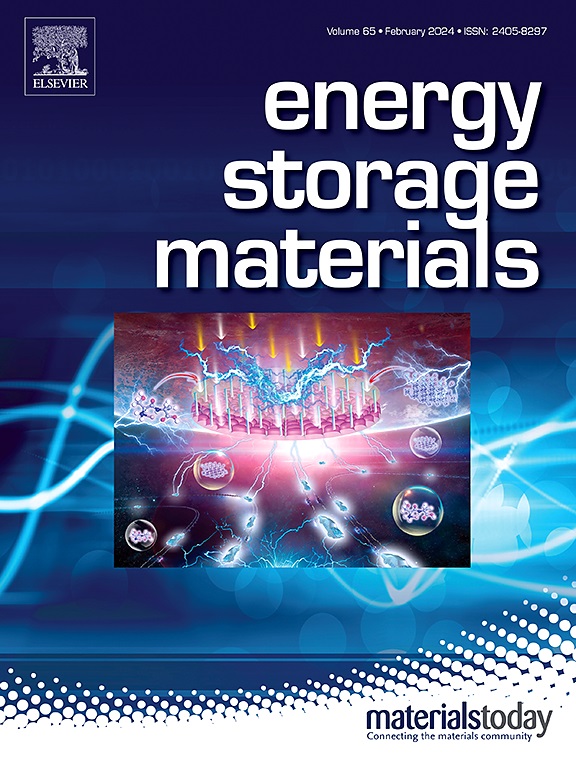Engineering high-performance argyrodite sulfide electrolytes via metal halide doping for all-solid-state lithium metal batteries
IF 20.2
1区 材料科学
Q1 CHEMISTRY, PHYSICAL
引用次数: 0
Abstract
Solid-state electrolytes (SSEs) play a crucial role in the operation of all-solid-state lithium metal batteries (ASSLMBs). Among them, sulfide SSEs have attracted particular attention due to their high ionic conductivity. However, the incompatibility of sulfide SSEs with lithium anodes and the inherent air instability severely impact battery cycling performance. Here, we successfully synthesize halogen-rich lithium argyrodites with the general formula Li5.5 + 3xP1−xCuxS4.5Cl1.5 − 2xBr2x. The incorporation of Cu and Br alter the spatial arrangement and electronic distribution of structure. Given that the anion disorder positively affects Li-ion dynamics, the ultrahigh ionic conductivity of 10.3 mS cm−1 at room temperature has been achieved in Li5.8P0.9Cu0.1S4.5Cl1.3Br0.2 (LPSC-CB). Importantly, benefiting from the robust and stable interlayer, the lithium symmetric batteries deliver prolonged plating/stripping over 3000 h at 0.2 mA cm−2. Furthermore, the density functional theory calculations were used to prove the mechanisms of high chemical stability. Notably, the LPSC-CB electrolyte has remarkable applicability in ASSLMBs. The full batteries of FeS2/LPSC-CB/Li deliver outstanding discharge-specific capacities of 788.9 mAh g−1 and robust cycling stability (>4.02 mAh cm−2 after 200 cycles). The versatile CuBr2 substitution in the most promising argyrodite electrolytes is considered as a valid strategy to realize high ionic conductivity and air-stabilized sulfide SSEs for large-scale applications.


全固态锂金属电池用金属卤化物掺杂制备高性能银硫化物电解质
固态电解质在全固态锂金属电池的运行中起着至关重要的作用。其中,硫化物硫醚因其离子电导率高而受到人们的特别关注。然而,硫化硫醚与锂阳极的不相容性以及其固有的空气不稳定性严重影响了电池的循环性能。本文成功合成了分子式为Li5.5+3xP1−xCuxS4.5Cl1.5−2xBr2x的富卤素银晶锂。Cu和Br的加入改变了结构的空间排列和电子分布。考虑到阴离子无序性对锂离子动力学的积极影响,Li5.8P0.9Cu0.1S4.5Cl1.3Br0.2 (LPSC-CB)在室温下实现了10.3 mS cm−1的超高离子电导率。重要的是,得益于坚固稳定的中间层,锂对称电池在0.2 mA cm - 2下的电镀/剥离时间超过3000小时。此外,利用密度泛函理论计算证明了高化学稳定性的机理。值得注意的是,LPSC-CB电解质在asslmb中具有显著的适用性。完整的FeS2/LPSC-CB/Li电池具有788.9 mAh g - 1的放电比容量和强大的循环稳定性(200次循环后4.02 mAh cm - 2)。在银镁石电解质中广泛的CuBr2取代被认为是实现高离子电导率和大规模应用的空气稳定硫化物的有效策略。
本文章由计算机程序翻译,如有差异,请以英文原文为准。
求助全文
约1分钟内获得全文
求助全文
来源期刊

Energy Storage Materials
Materials Science-General Materials Science
CiteScore
33.00
自引率
5.90%
发文量
652
审稿时长
27 days
期刊介绍:
Energy Storage Materials is a global interdisciplinary journal dedicated to sharing scientific and technological advancements in materials and devices for advanced energy storage and related energy conversion, such as in metal-O2 batteries. The journal features comprehensive research articles, including full papers and short communications, as well as authoritative feature articles and reviews by leading experts in the field.
Energy Storage Materials covers a wide range of topics, including the synthesis, fabrication, structure, properties, performance, and technological applications of energy storage materials. Additionally, the journal explores strategies, policies, and developments in the field of energy storage materials and devices for sustainable energy.
Published papers are selected based on their scientific and technological significance, their ability to provide valuable new knowledge, and their relevance to the international research community.
 求助内容:
求助内容: 应助结果提醒方式:
应助结果提醒方式:


